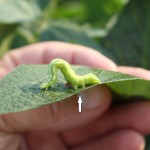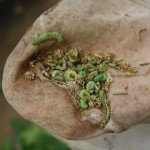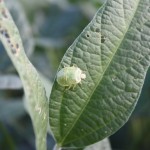Predictably, insect populations are increasing in some soybean fields. Although there are no widespread problems, there are enough to justify vigilant scouting of late planted soybean fields.
Corn Earworm – There are a few fields that have been recently treated for this pod-feeding pest. At this late date, treatment level infestations are only likely in very late maturing fields (those at R4 or less mature). The treatment threshold is an average of 9 larvae per 25 sweeps. I’ve had two reports of less than stellar control with synthetic pyrethroids. This is becoming common enough that I would typically avoid using the pyrethroids for corn earworm control. Instead, I suggest using alternative chemistries such as Belt SC, Besiege, Prevathon, Steward, Tracer, Radiant SC or Intrepid Edge. These products may help prevent or delay infestations of other caterpillars such as soybean loopers, which will be more likely in these same late maturing fields.
Loopers – Soybean or cabbage loopers are being more commonly observed. Many appear to be soybean loopers which, unlike cabbage loopers, are not well controlled by pyrethroid insecticides. Treatment should be made when 20% or more defoliation is observed before R6. Once you reach R6, you should increase this threshold to 30-35% defoliation until approximately R7. Treatment is not recommended at R7 or later. In reality, I would not recommend treatment after R6 + 10-14 days. Do not use pyrethroid insecticides. Use Intrepid or the products mentioned above for control of corn earworm.
Tip – It takes about 20 loopers per 25 sweeps to cause about 20% defoliation. It is often suggested to ignore larvae less than 1/4-inch long because they do little feeding and often have high mortality rates. Green cloverworm may be part of the caterpillar complex. Make sure you know how to distinguish green cloverworm with loopers. I’ve reviewed this in several previous articles but also included some pictures below.
Stink Bugs – Always a potential player as soybean approach R5 and R6, treatment is recommended up to R6 when populations average 9 or more stink bugs per 25 sweeps. Double this threshold once you are 10-14 days past R6. At this time, stink bugs will have little if any effect on yield, really only impacting seed quality. Treatment at R7 would only be recommended for very large populations on seed beans. Pyrethroid insecticides are commonly used, but Acephate/Orthene is another option. Be sure to check the pre-harvest (PHI) on the label before making an application.





